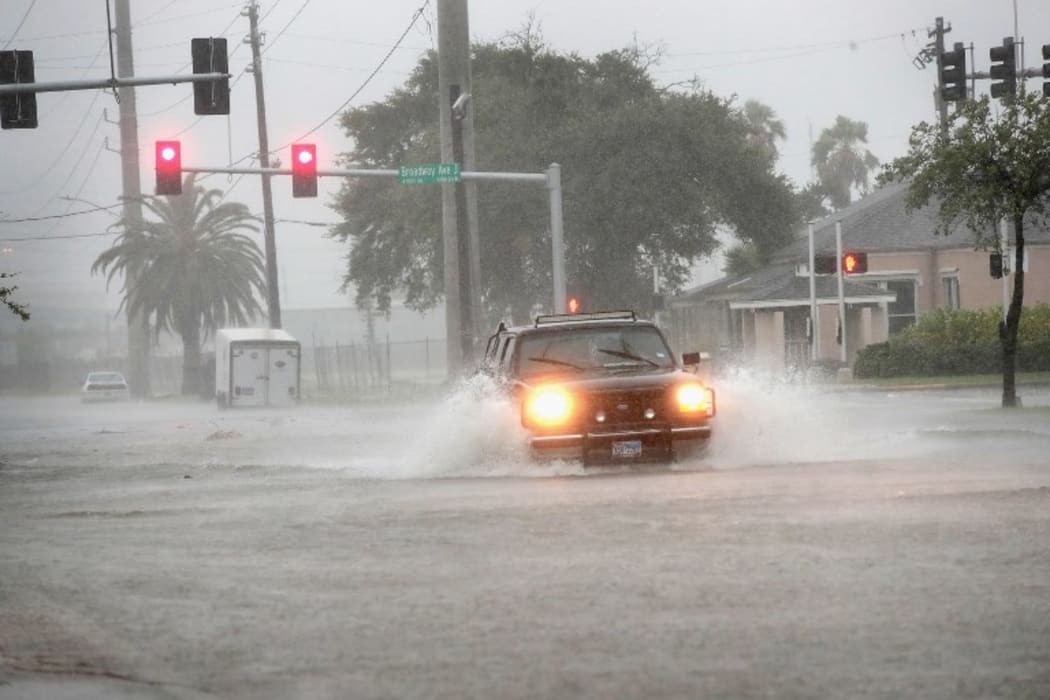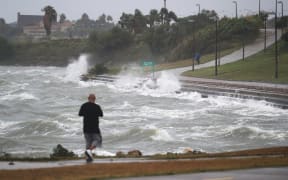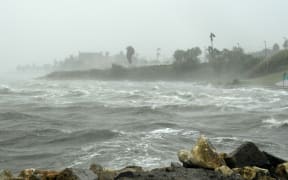US authorities are warning of catastrophic, life-threatening flooding in Texas.
Hurricane Harvey made landfall as a category four storm with 200 km/h winds before being downgraded to a tropical storm. Despite the downgrading, the National Hurricane Centre warned of life-threatening hazards, heavy rainfall, flooding in southeast Texas and storm surges along parts of the coast.

An image of Hurricane Harvey by Nasa astronaut Randy Bresnik. Photo: Nasa
Rainfall intensity could reach 1m, with heavy rain and flooding forecast for parts of the state until Thursday.
Major damage has been reported in several cities and utility companies reported 240,000 customers were without power.
Harvey was the most powerful storm to hit Texas in more than 50 years and dumped torrential rain as it moved inland on Saturday.

A car lies abandoned after heavy damage in Rockport, Texas. Photo: AFP
Tropical Storm Harvey is expected to lash Texas for days. It also triggered tornadoes and flash floods.

A car navigates a street flooded by rain from Hurricane Harvey in Galveston, Texas. Photo: AFP
Harvey was the strongest storm to hit the state, the center of the US oil and gas industry, since 1961. It came ashore as a hurricane with winds of 209 km/h.
More devastation and now flooding with westerlies on south side of #Harvey in Rockport, TX. River flooding now concern N @breakingweather pic.twitter.com/0fCGWFyAMu
— Reed Timmer (@ReedTimmerAccu) August 26, 2017
That made Harvey a Category 4 hurricane on the Saffir-Simpson scale, the second-highest category and the most powerful storm in over a decade in the mainland United States.
There were no reported fatalities, Texas Governor Greg Abbott said on Saturday. Abbott said he will activate 1800 members of the military to help with the cleanup while 1000 people conduct search-and-rescue operations.
The little town of Rockport has suffered severe damage from #HurricaneHarvey. pic.twitter.com/fBZFMABaKZ
— James Cook (@BBCJamesCook) August 26, 2017
The seaside town of Rockport, 48 km north of the city of Corpus Christi, took a direct hit.
Harvey destroyed many homes and damaged many commercial buildings. The wind ripped off roofs and smashed windows.
The streets were flooded and strewn with power lines and debris on Saturday. At a recreational vehicle sales lot, a dozen vehicles were flipped over and one had been blown into the middle of the street.
"It was terrible," resident Joel Valdez, 57, told Reuters. The storm ripped part of the roof from his trailer home at around 4 am, he said. "I could feel the whole house move."
Valdez said he stayed through the storm to look after his animals.
"I have these miniature donkeys and I don't know where they are," he said, as he sat in a Jeep with windows smashed by the storm.
Resident Frank Cook, 56, also stayed through the storm.
"If you have something left of your house, you're lucky," he said, surveying the damage from his vehicle.
Before the storm hit, Rockport's mayor told anyone staying behind to write their names on their arms for identification in case of death or injury.
A high school, hotel, senior housing complex and other buildings suffered structural damage, according to emergency officials and local media. Some were being used as shelters.
The coastal city of Port Lavaca, farther north on the coast, had no power and some streets were flooded.
"There is so much tree damage and debris that the cost of cleanup will be enormous," Mayor Jack Whitlow told Reuters, after touring the city earlier Saturday.
The streets of Corpus Christi, which has around 320,000 residents, were deserted on Saturday, with billboards twisted and strong winds still blowing.
City authorities asked residents to reduce use of toilets and faucets because power outages left waste water plants unable to treat sewage.
A drill ship broke free of its mooring overnight and rammed into some tugs in the port of Corpus Christi, port executive Sean Strawbridge said. The crews on the tugs were safe, he added.
The city was under voluntary evacuation ahead of the storm.
The latest forecast storm track has Harvey looping back toward the Gulf of Mexico coast before turning north again on Tuesday.
"This rain will lead to a prolonged, dangerous, and potentially catastrophic flooding event well into next week," the National Weather Service said. Harvey has triggered flash floods, the NWS said.
The size and strength of Harvey dredged up memories of Katrina, the 2005 hurricane that made a direct hit on New Orleans as a Category 3 storm, causing levees and flood walls to fail in dozens of places.
About 1800 died in the disaster made worse by a slow government emergency response.
- Reuters / RNZ



